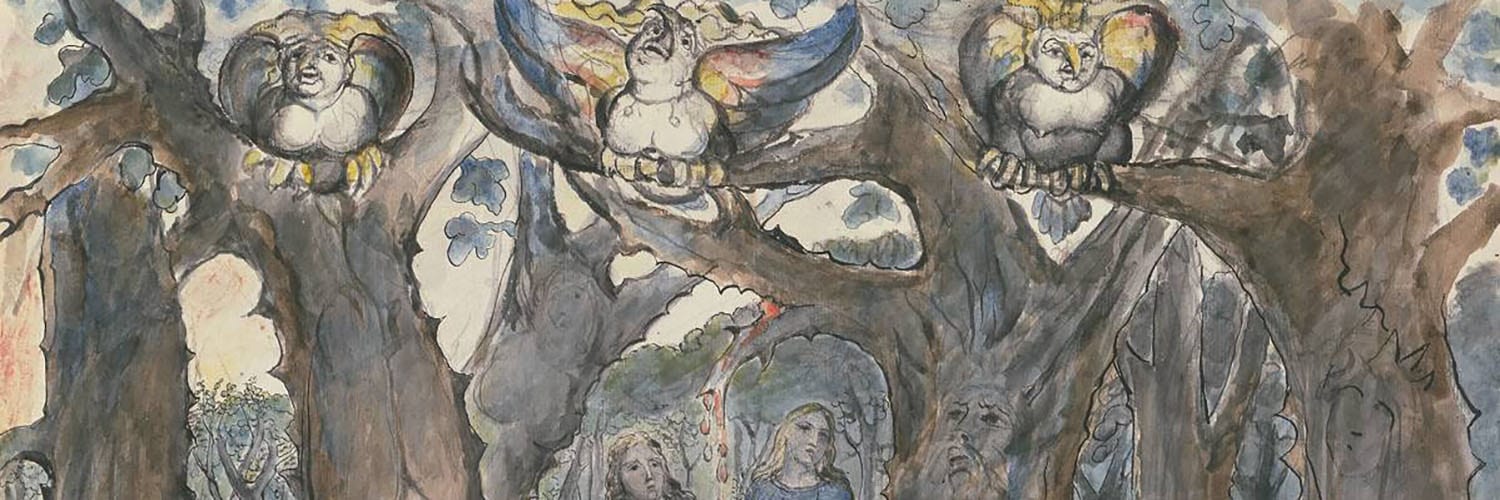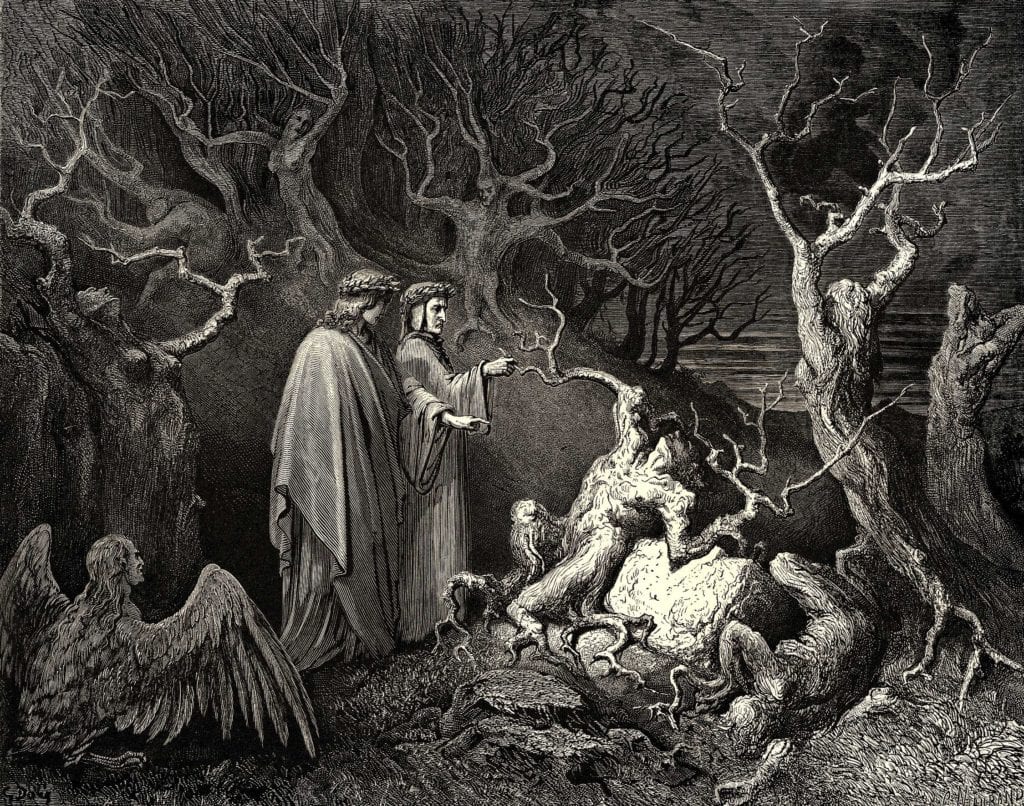Hell’s Vineyard (Inferno 13)

Dante and Virgil are in the seventh circle of Hell where violence is punished. In the second section, those who had been violent to themselves have been transformed into trees. Pier delle Vigne, Holy Emperor Frederick II’s adviser, almost a contemporary of Dante, is condemned to this part of Hell for committing suicide.
Hell’s Vineyard: Introduction to Inferno 13
Presented by Theodore J. Cachey Jr.
Stopped at the gate of Dis by the Furies and Medusa, Dante and Virgil have to wait for the intervention of the angelic messenger in order to be admitted into the city of Dis (canto 9), or lower Hell, whose walls enclose the sixth, seventh, eighth, and ninth circles, where heresy, violence, fraud, and treachery respectively are punished. After passing through the sepulchers of the cemetery in the sixth circle, where heresy is punished, and encountering Farinata degli Uberti, belonging to the opposite Florentine political faction to Dante’s own (canto 10), Dante and Virgil resume their journey and Virgil explains the structure of Hell (canto 11): in the first section of Hell, incontinence is punished. That can be defined as an irrational lack of control over an excess of wrongly directed love and bodily appetites for ephemeral goods such as with lust (second circle), gluttony (third circle), avarice and prodigality (fourth circle), and anger and sullenness (fifth circle). Lower Hell, instead, is characterized by sins of malice, a conscious intention to commit evil and resulting into violence, fraud, and treachery. Violence is punished in the seventh circle and its three rings (1st ring: violence against neighbor [homicides, tyrants, and plunderers]; 2nd ring: violence against self [suicides and spendthrifts]; 3rd ring: violence against God [blasphemers, homosexuals, and usurers]) are guarded by the Minotaur and the Harpies, between cantos 12-17.

After crossing the Phlegethon, the river of blood, protected by the Centaur Nessus (canto 12), Dante and Virgil, at the beginning of canto 13, get to the wood of suicides, presided over by the Harpies, monstrous women-birds from the classical tradition, where dead souls become thorn bushes. Those who despised their own body in life are now eternally deprived of it and assigned a degraded vegetal body. There, they encounter Pier delle Vigne (c. 1190-1249) who had been judge of the Supreme Court of the Emperor of the Holy Roman Empire and King of Sicily Fredrick II (1194-1250) and one of the kingdom’s prominent diplomats. Pier delle Vigne had probably contributed to the redaction of the Constitutions of Melfi, a legal code for the Kingdom of Sicily promulgated by Frederick II in 1231 and to the development of the writing style used for the composition of legal documents at Frederick’s chancery. He had also been a poet among other poets and artists who had made Frederick’s court an incredibly lively center of culture. Accused of corruption and arrested, he committed suicide in prison. The soul of Dante’s Pier in canto 13 is trapped inside the thorn bush he has become, as Dante finds out when Virgil encourages him to detach a twig from it and the bush speaks words mixed with blood. In a speech organized according to the elaborate rhetorical code typical of public speaking and writing in the Middle Ages, Pier presents himself as
‘[…] the one who held both keys
To Frederick’s heart, and I could turn them,
Locking and unlocking, so discreetly
I kept his secrets safe from almost everyone.
So faithful was I to that glorious office
That first I lost my sleep and then my life.
(Inferno XIII 58-63)
Led to suicide by unjust accusations, Pier delle Vigne’s (and Dante-poet’s) goal in this speech is to restore Pier’s own honor:
‘By this tree’s new-sprung roots I give my oath:
Not once did I break faith
With my true lord […]’.
(Inferno XIII 73-74)
Dante-pilgrim and exile, on the path to restore his own reputation against the accusations that had caused his banishment from Florence, deeply identifies with Pier’s character, to the point that the pity he feels prevents him from being able to continue the conversation with Pier. On the other hand, the limitations of Pier’s moral horizon are clear compared to Dante’s own: Pier, in order to ‘escape from scorn’ though just towards his office turned unjust against himself and God’s law by committing suicide. Dante, placed in the same situation, accepts the hard path of exile.
"What’s wrong with this picture?" Pier delle Vigne
Presented by Theodore J. Cachey Jr.
This video introduces the seventh circle of Hell where violence is punished and, in particular, the wood of suicides.
Pier delle Vigne and Holy Roman Emperor Frederick II
Presented by Chiara Sbordoni
This video introduces the historical figure of the Holy Roman Emperor Frederick II, whose court in Southern Italy gave rise to the first important lyric poetry in an Italian vernacular, including the poetry of his counselor Pier delle Vigne.
Polydorus, the Bleeding Bush
Presented by David Lummus
This video introduces the figure of Polydorus, a character from Virgil’s “Aeneid” and literary antecedent to Dante’s Pier delle Vigne.
Prepare for Next Week
Presented by Theodore J. Cachey Jr.
Read Inferno 18 and Inferno 27.
Reading Questions:
1. Identify the location in the map of Hell of the sinners and describe the punishments of the sinners in these two cantos. How do the locations in the Inferno express something about the nature of fraud, and how do the punishments, or contrapassos, express the nature of the specific sins punished in these cantos?
2. How do you interpret the significance of the simile of the Jubilee bridge in Inferno 18, lines 25-33, where the sinners in the first pouch are compared to the pilgrims to Rome?
3. Analyze the speech of the false counselor Guido da Montefeltro in Inferno 27, lines 58-132. What are some of the key rhetorical figures and expressions that reveal Guido’s personality and his sin?
4. Analyze carefully Inferno 27, lines 94-99, in which Guido compares himself and Boniface VIII to Constantine and Pope Sylvester. What’s wrong with this picture?
Additional Resources
Presented by Theodore J. Cachey Jr.
- Short Video: La Divina Commedia Inferno 13 in HD (with English subtitles available; 3 minutes)
- Article: Leo Spitzer, “Speech and Language in Inferno XIII.” Italica, vol. 19, no. 3, 1942, pp. 81–104. JSTOR, www.jstor.org/stable/475521.
- A list of Dante’s Works
- Dante Chronology from the Cambridge Companion to Dante
View the Event
Presented by Theodore J. Cachey Jr.
Subscribe to the ThinkND podcast on Apple, Spotify, or Google.
Featured Speakers:
- Theodore J. Cachey, Professor of Italian and the Albert J. and Helen M. Ravarino Family Director of Dante and Italian Studies, University of Notre Dame; Co-Director, University of Notre Dame Center for Italian Studies
- David Lummus, Visiting Professor of Italian and Co-Director, University of Notre Dame Center for Italian Studies
- Chiara Sbordoni, Adjunct Professor of Italian, University of Notre Dame Rome Global Gateway
